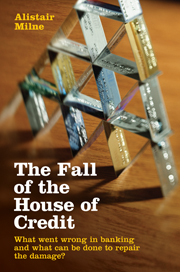 The Fall of the House of Credit
The Fall of the House of Credit Published online by Cambridge University Press: 23 December 2009
In the first half of 2007 loan losses emerged in one loan market segment – the US sub-prime mortgage market. This was not such a surprise. There had been warnings about unsustainable growth of house prices in the United States and other countries for some years. Sub-prime was the riskiest category of mortgage lending. Lenders knew well enough that losses were bound to emerge at some point.
They thought they were prepared. There was a lot of money committed to sub-prime mortgage lending – around $1.3 trillion dollars, or 10 cents for every dollar of US national income. But prospective losses in this market, even on pessimistic projections, looked to be perfectly containable. As I complete this book, taking a cautious view of losses on this sub-prime lending, it looks as though they might climb to around $300 billion dollars (the justification for this figure was given above in Chapter 1). This sounds like the sort of credit problem that banks can put behind them – recognize the losses and move on.
The huge surprise has been the wider impact of emerging losses on US sub-prime mortgage lending, first triggering bank failures in Germany and the United Kingdom, raising the cost of funding bank loan portfolios across the globe, and eventually triggering the run on the global banking system in September and October 2008. Why did the sub-prime losses have such a big impact? What were the links that transmitted this shock around the globe? This chapter tells part of the story, from the first emergence of problems in early summer 2007 to the failure of the UK bank Northern Rock in September of that year.
To save this book to your Kindle, first ensure no-reply@cambridge.org is added to your Approved Personal Document E-mail List under your Personal Document Settings on the Manage Your Content and Devices page of your Amazon account. Then enter the ‘name’ part of your Kindle email address below. Find out more about saving to your Kindle.
Note you can select to save to either the @free.kindle.com or @kindle.com variations. ‘@free.kindle.com’ emails are free but can only be saved to your device when it is connected to wi-fi. ‘@kindle.com’ emails can be delivered even when you are not connected to wi-fi, but note that service fees apply.
Find out more about the Kindle Personal Document Service.
To save content items to your account, please confirm that you agree to abide by our usage policies. If this is the first time you use this feature, you will be asked to authorise Cambridge Core to connect with your account. Find out more about saving content to Dropbox.
To save content items to your account, please confirm that you agree to abide by our usage policies. If this is the first time you use this feature, you will be asked to authorise Cambridge Core to connect with your account. Find out more about saving content to Google Drive.